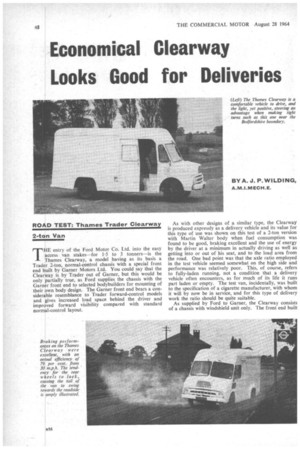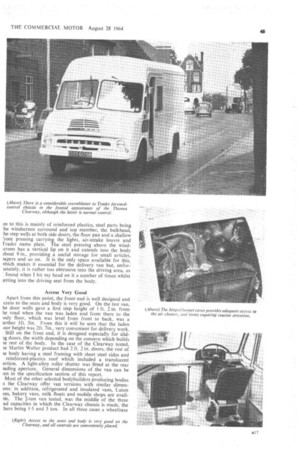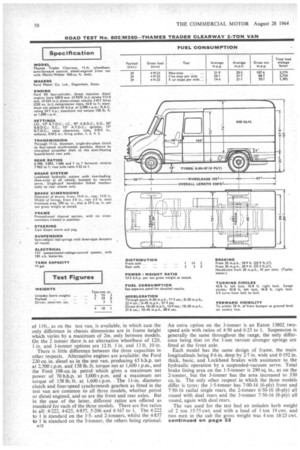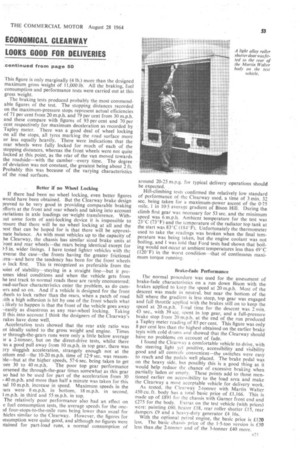Economical Clearway Looks Good for Deliveries
Page 50

Page 51

Page 52

Page 55

If you've noticed an error in this article please click here to report it so we can fix it.
BY A. J. P.WILDING, RO D TEST: Thames Trader Clearway 2-ten Van TE entry of the Ford Motor Co. Ltd. into the easy ccess van stakes—for 1-5 to 3 tonners—is the hames Clearway, a model having as its basis a Trad r 2-ton, normal-control chassis with a special front end iullt by Garner Motors Ltd. You could say that the Clear ay is by Trader out of Garner, but this would be only sartially true, as Ford supplies the chassis with the Garn r front end to selected bodybuilders for mounting of their iwn body design. The Garner front end bears a consider ble resemblance to Trader forward-control models and9 ves increased load space behind the driver and impr I ved forward visibility compared with standard norm 1-control layout.
As with other designs of a similar type, the Clearway is produced expressly as a delivery vehicle and its value for this type of use was shown on this test of a 2-ton version with Martin Walter body when fuel consumption was found to be good, braking excellent and the use of energy by the driver at a minimum in actually driving as well as getting into or out of his seat, and to the load area from the road. One bad point was that the axle ratio employed in the test vehicle seemed somewhat on the high side and performance was relatively poor. This, of course, refers to fully-laden running, not a condition that a delivery vehicle often encounters, as for much of its life it runs part laden or empty. The test van, incidentally, was built to the specification of a cigarette manufacturer, with whom it will by now be in service, and for this type of delivery work the ratio should be quite suitable.
As supplied by Ford to Garner, the Clearway consists of a chassis with windshield unit only. The front end built an to this is mainly of reinforced plastics, steel parts being he windscreen surround and top member, the bulkhead, :he step wells at both side doors, the floor pan and a shallow !font pressing carrying the lights, air-intake louvre and Frader name plate. The steel pressing above the wind;creen has a vertical lip on it and extends into the body tbout 9 in„ providing a useful storage for small articles, mpers and so on. It is the only space available for this, vhich makes it essential for, the delivery van but, unforunately, it is rather too obtrusive into the driving area, as found when I hit my head on it a number of times whilst :etting into the driving seat from the body.
Access Very Good Apart from this point, the front end is well designed and ,ccess to the seats and body is very good. On the test van, he door wells gave a first step height of I ft. 2 in. from he road when the van was laden and from there to the ody floor, which was level from front to back, was a urther Ift. 5in. From this it will be seen that the laden our height was 2ft. 7in., very convenient for delivery work. Still on the front end, if is designed especially for slidig doors, the width depending on the concern which builds le rest of the body. In the case of the Clearway tested, le Martin Walter product had 2 ft. 2 in. doors, the rest of le body having a steel framing with sheet steel sides and reinforced-plastics roof which included a translucent onion. A light-alloy roller shutter was fitted at the rear )ading aperture. General dimensions of the van can be en in the specification section of this report. Most of the other selected bodybuilders producing bodies a the Clearway offer van versions with similar dimenons; in addition, refrigerated and insulated vans, Luton tns, bakery vans, milk floats and mobile shops are avail)1e. The 2-ton van tested, was the middle of the three ad capacities in which the Clearway chassis is made, the :hers being 1-5 and 3 ton. In all three cases a wheelbase of lift., as on the test van, is available, in which case the only difference in chassis dimensions are in frame height which varies by a maximum of 2in. only between models. On the 2 tonner there is an alternative wheelbase of 12ft. 1 in. and 3-tonner options are 12 ft. 1 in. and 13 ft. 10 in.
• There is little difference between the three capacities in other respects. Alternative engines are available: the Ford 220 cu. in. diesel as in the test van, producing 65 b.h.p. net at 2,500 r.p.m. and 158 lb. ft. torque net at 1,600 r.p.m., and the Ford 198-cu. in. petrol which gives a maximum net power of 70 b.h.p. at 3,000 r.p.m. and a maximum net torque of 158 lb. ft. at 1,600 r.p.m. The 11-in, diameter clutch and four-speed synchromesh gearbox as fitted in the test van are common to all three models, whether petrol or diesel engined, and so are the front and rear axles. But in the case of the latter, different ratios are offered as standard for each of the three models. There are five ratios in all: 4.222, 4.625, 4-857, 5.206 and 6167 to 1. The 4-222 to 1 is standard on the 1-5and 24onners, whilst the 4.857 to I is standard on the 3-tonner, the others being optional.
1118 An extra option on the 3-tonner is an Eaton 13802 twospeed axle with ratios of 4-50 and 6.25 to I. Suspension is generally the same throughout the range, the only difference being that on the 3-ton version stronger springs are fitted at the front axle.
Each model has the same design of frame, the main longitudinals being 8.6 in. deep by 2.7 in. wide and 0.192 in. thick, basic, and Lockheed brakes with assistance to the hydraulic operation by a suspended-vacuum servo. Total brake lining area on the 1.5-tonner is 290 sq. in., as on the 2-tonner, but the 3-tonner has the area increased to 330 cu. in. The only other respect in which the three models differ is tyres: the 1.5-tonner has 7-00-16 (6-ply) front and 7.50-16 radial single rears, the 2-tonner 6.50-16 (8-ply) all round with dual rears and the 3-tonner 7-50-16 (8-ply) all round, again with dual rears.
The van used for the test had an unladen kerb weight of 2 ton 15.75 cwt. and with a load of 1 ton 19 cwt. and two men in the cab the gross weight was 4 ton 18-25 cwt. continued on page 53 This figure is only marginally (4 lb.) more than the designed maximum gross weight of 11,000 lb. All the braking, fuel consumption and performance tests were carried out at this gross weight.
The braking tests produced probably the most commendable figures of the test. The stopping distances recorded on the maximum-pressure stops represent actual efficiencies of 71 per cent from 20 m.p.h. and 79 per cent from 30 m.p.h. and these compare with figures of 93 per cent and 70 per cent respectively for Maximum deceleration as recorded by Tapley meter. There was a good deal of wheel locking on all the stops, all tyres marking the road surface more or less equally heavily. There were indications that the rear wheels were fully locked for much of each of the stopping distances, whereas the front wheels were not quite locked at this point, as the rear of the van moved towards the roadside—with the camber—every time. The degree of deviation was not constant, the greatest being about 2 ft. Probably this was because of the varying characteristics of the road surfaces.
Better if no Whod Locking
If there had been no wheel locking, even better figures would have been obtained. But the Clearway brake design proved to be very good in providing comparable braking efforts at the front and rear wheels and taking into account variations in axle loadings on -weight transference. With3ut some forin of anti-locking device it is impossible to msure that there will be no wheel locking at all and the 3est that can be hoped for is that there will be approxi-nate balance. As with most vehicles up to the capacity of he Clearway, the chassis has similar sized brake units at 'rant and rear wheels—the rears being identical except for 1-5 in. wider linings. I have tested lighter vehicles with the
everse the case the fronts having the greater frictional rea—and here the tendency has been for the front wheels o lock first. This is recognized as preferable from the ■ oint of stability—staying in a straight line—but it pretimes ideal conditions and when the vehicle gets from he test track to normal roads these are rarely encountered; oad-surface characteristics enter the problem, as do earners and so on. And if a vehicle is designed for the front /heels to lock rather than the rears, when a patch of road fith a high adhesion is hit by one of the front wheels what ;likely to happen is that the front of the vehicle goes away --easily as disastrous as any rear-wheel locking. Taking 11 this into account 1 think the designers of the Clearway's rakes have done well.
Acceleration tests showed that the rear axle ratio was ot ideally suited to the gross weight and engine. Times 3r through-the-gears runs were only a little below average 3t. a 2-tanner, but on the direct-drive tests, whilst there 'as a good pull away from 10 m.p.h. in top gear, there was ery sluggish acceleration, strangely enough not at the ottom end--the 10-20 m.p.h. time of 12-9 sec. was reasonble—but at the higher speeds, 57-6 sec. being taken to get -om 30 to 40 m.p.h. The poor top gear performance orsened the through-the-gear times somewhat as this gear so had to be used for part of the acceleration from 30 40 m.p.h. and more than half a minute was taken for this "al 10 mph. increase in speed. Maximum speeds in the !ars were 8 m.p.h. in bottom, 18 m.p.h. in second, 1m.p.h. in third and 55 m.p.h. in top.
The relatively poor performance also had an effect on e fuel consumption tests, the average speeds for the (meld four-stops-to-the-mile runs being lower than usual for hides similar to the Clearway. However, the figures for insumption were quite good, and although no figures were )tained for part-load runs, a normal consumption of around 20-25 m.p.g. for typical delivery operations should be expected.
Hill-climbing tests confirmed the relatively low standard of performance of the Clearway used, a time of 3 min. 32 sec. being taken for a maximum-power ascent of the 0-75 mile, l in 10-5 average gradient of Bison Hill. During the climb first gear was necessary for 53 sec. and the minimum speed was 6 m.p.h. Ambient temperature for the test was 23°C (73°F) and the temperature of the radiator top tank at the start was 83`C (184"F). Unfortunately the thermometer used to take the readings was broken when the final temperature was being taken, but the engine coolant was not boiling, and I was told that Ford tests had shown that boiling would not occur at ambient temperatures less than 49°C (120°F) in the worst condition—that of continuous maximum torque running.
Brake-fade Performance
The normal procedure was used for the assessment of brake-fade characteristics on a run down Bison with the brakes applied to keep the speed at 20 m.p.h. Most of the descent was made in neutral, but near the bottom of the hill where the gradient is less steep, top gear was engaged and full throttle applied with the brakes still on to keep the speed at 20 m.p.h. Total time for the descent was 2 min. 43 sec., with 39 sec. spent in top gear, and a full-pressure brake stop from 20 m.p.h. at the end of the run produced a Tapley meter reading of 85 per cent. This figure was only 8 per cent less than the highest obtained on the earlier brake tests with cold drums and showed that the Clearway should have no problems on account of fade.
found the Clears ay a comfortable vehicle to drive, with the steering light yet positive, accessibility and visibility good and all controls convenient—the switches were easy to reach and the pedals well placed. The brake pedal was on the heavy side, but possibly this is a good thing as it would help reduce the chance of excessive braking when partially laden or empty. These points add to those mentioned earlier on accessibility to the load area and make the Clearway a most acceptable vehicle for delivery work.
As tested, the Clearway 2-tonner with Martin Walter 450 Cu. ft. body has a total basic price of £1,166. This is made up of £891 for the chassis with Garner front end and £275 for the body. Extras on the test vehicle (with prices) were: painting £60, heater £18, rear roller shutter £15, rear dampers £9 and a heavy-duty generator £4 16s.
With the optional petrol engine, the basic price is £120 less. The basic chassis price of the, 1-5-ton version is £30 less than .the 2-tonner and of the 3-tonner £40 more.




















































































































